Insect Damage
Yellow leaves with a shiny or sticky substance on surfaces
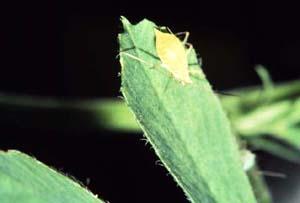
Cause
Aphids, especially the pea aphid (Acyrthosiphon pisum). These small soft-bodied insects are less than 1/8 inch long and appear in a variety of colors. Using piercing-sucking mouth parts, aphids remove plant sap and often spread disease in the process. Ants are often drawn to their sticky excrement.
Treatment
Pods are rarely damaged. Treatment is usually not required as many natural predators such as lady beetles exist. However in widespread infestations (more than 50% of all leaves in field infested), action may be necessary. Low toxicity insecticidal soaps and horticultural oils are highly effective.
Deformed and pitted pods and seeds, and dropping blossoms and young pods
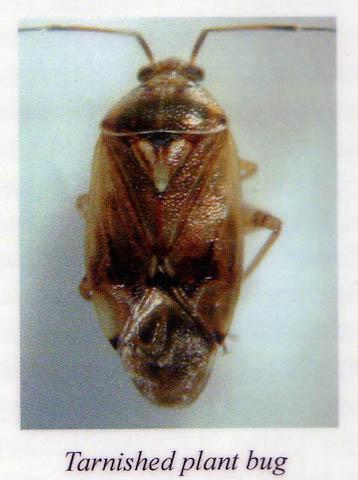
Cause
The lygus bug, several related species including the tarnished plant bug (Lygus lineolaris). These small (1/4 inch long) insects are mottled white or yellow in color with black pathces. The overall body shape is similar to that of the boxelder bug. Because of their small size, the lygus bug is rarely seen. Feeding damage causes blossoms and young pods to fall from the plant.
Treatment
Eliminate weeds and crop residue near pea fields as these provide overwintering sites. Also avoid planting peas near alfalfa or canola.
Stems cut off near soil surface
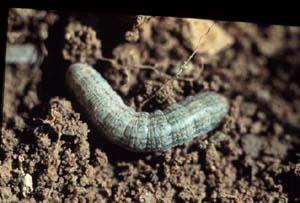 |
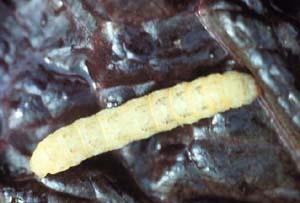 |
Cause
Cutworms--the larva of several species of moths.Cutworms appear in a variety of colors including gray, brown, and black and may be stripped or spotted. Cutworms like other caterpillars are soft bodied and reach sizes up to 1 1/4 inch in length. When disturbed, cutworms curl up.
Treatment
Remove cutworms by hand in small plantings. In large plantings, use approved formulations of Bt or other pesticide labelled for this pest. Apply these pesticides when cutworms are young and small if possible.
Holes and chewed leaf edges
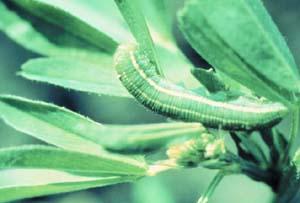 |
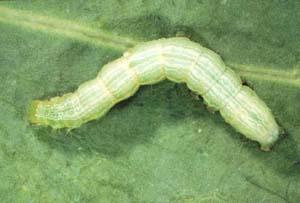 |
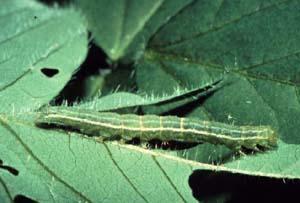 |
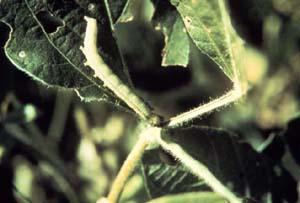 |
Cause
Caterpillars, the larva of various moth species including:
The alfalfa caterpillar (Plathypena scabra), the celery looper (Anagrapha falcifera), and the cabbage looper (Trichoplusia ni).
Feeding damage of these and other caterpillars is characterized by chewing of leaf or fruit surfaces sometimes accompanied by dark green or black droppings. Individual color patterns of caterpillars can vary, and the green color of many species makes them difficult to spot.
Treatment
Remove caterpillars by hand in small plantings. In large plantings, use approved formulations of Bt or other pesticide labelled for this pest. Apply these pesticides when caterpillars are young and small if possible, and when populations exceed 0.5 caterpillars per plant.
Disease Symptoms
Wilting and dead plants with soft, wet, and dark roots
Cause
Aphanomyces root rot (Aphanomyces euteiches), a fungal disease which is more severe in warm rainy weather.
Treatment
No resistant cultivars are available and no approved fungicides exist. Rotate crops annually, do not plant peas following other legume crops.
Black or purple streaks on stems and lesions on leaves, stems pods, or roots--sometimes in concentric rings
Cause
Ascochyta blight, a disease caused by any of three different fungi (Ascochyta spp.). This disease is worse in rainy conditions.
Treatment
No resistant cultivars are available and no approved fungicides exist. Rotate crops annually, do not plant peas following other legume crops.
Brown or red swollen and brittle stem tissue near the soil line and yellowing leaves
Cause
Fusarium wilt (Fusarium oxysporum), a fungal disease. Other symptoms include wilting and yellowing leaves, starting from the bottom of the plant and moving up.
Treatment
Resistant cultivars are available, contact your local Extension agent or seed dealer for currently available varieties.
Seedlings that shrivel and die shortly after germination
Cause
Damping off, a disease condition caused by two fungi (Pythium spp. and Rizoctonia solani).
Treatment
Avoid planting in wet soils, use seeds treated with fungicides if possible.
Shiny dark, wet lesions
Cause
Bacterial blight (Pseudomonas syringae). Lesions become dark and necrotic and are worse in rainy and windy conditions.
Treatment
Avoid overhead irrigation. Plant resistant varieties.